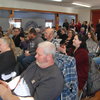Helderberg Ambulance, needing recruits, looks to SUNY
— Photo from Alan Zuk
Gerry Cross, left, of Berne, being honored by Alan Zuk last year for 60 years of volunteer work helping his neighbors on ambulance rescue calls, first with the Berne Fire Company and then with the Helderberg Ambulance Squad. Both retired from Helderberg Ambulance this year, along with three other long-time members.
HILLTOWNS — To maintain its current level of service, Helderberg Ambulance needs to get five new recruits each year, Captain Neal Hogan estimates — no easy task for a volunteer-based organization whose counterparts in Westerlo and Rensselaerville have shut down in the past few years due to lack of volunteers.
To help make things easier, the not-for-profit organization is hoping to establish a scholarship fund at State University of New York College of Agriculture and Technology at Cobleskill, through which it would contribute money to five students each semester who are part of the school’s emergency medical services program in exchange for their help on calls.
“The scholarships are just about $5,000 per semester per student,” Hogan said. “Essentially, if they cover a couple of shifts for us, and use that to improve their [learning] experience, we’ll either pay for their dorm bill or give them student loan repayment.”
To make this plan work, the two towns served by Helderberg Ambulance, Berne and Knox, would have to contribute more money than formerly for ambulance service, but each town has expressed its willingness to do so, Hogan said.
Altogether, the squad is asking over $112,000 from Berne, a $28,000 increase; and $56,000 from Knox, a $14,000 increase. Helderberg Ambulance covers all of Berne and part of Knox; the other part of Knox is covered by the Altamont Rescue Squad.
Berne, Hogan said, “is going to fund us in two different ways: a basic contribution from their general fund, and then they also receive reimbursement for advanced life support calls.”
Knox has yet to pass its 2023 budget, but Supervisor Russell Pokorny told The Enterprise that the prevailing thought among the board regarding the increase is, “These are really good people doing a job we need and we’re just going to have to pay it.”
As far as the price per taxpayer, Hogan said the increase amounts to less than fifty cents per $1,000 of assessed value. That would total $50 for a $100,000 property.
“We’re trying not to be a burden on the towns,” he said, emphasizing that none of that money goes toward paying the volunteers.
Plus, as The Enterprise has reported in the past, local service tends to be cheaper than the alternative, which is relying on the Albany County Sheriff’s Office. In 2019, then-Westerlo Supervisor William Bichteman was “flabbergasted” at the cost of outside service, which he said would be 20 to 25 percent more expensive for the town.
With any luck, the increased cost of Heldberg Ambulance service will only be temporary, as Hogan said he hopes that what turned out to be a comparatively stellar recruitment outcome this year, with nine new local recruits, will allow the squad to discontinue the scholarship in a couple of years “unless there’s another good reason to keep it going.”
Keeping up the recruitment rate will go against what the national trend has been for rural ambulance services. A 2018 report by the National Rural Health Association cites a national survey finding that 69 percent of rural EMS directors reported problems with staffing, with 55 percent saying the problem has been getting worse instead of better.
The report suggested that the two most prevalent reasons for the challenges for volunteers were demands from their jobs and/or families, with out-of-town workers being unavailable for weekday shifts, and family demands making it hard to find time on the weekends.
“It used to be that employers could afford to let their employees who were on the ambulance squad leave in the middle of the day to handle a call,” Hogan said of what he’s noticed in the Hilltowns. “Most employers can’t do that anymore.”
Furthermore, he said, farming families, which used to contribute a large number of volunteers, are making less money than they used to, with would-be volunteers instead opting for second jobs to make ends meet.
Consequently, the average age of the top five responders for the Helderberg squad last year was 71, according to a Volunteer Voices column submitted to The Enterprise by Millie Zuk. Those responders, she wrote, took 64 percent of the squad’s calls.
Helderberg Ambulance currently has 45 members, Hogan said, 10 of whom are EMTs, with three who are currently in training. The majority of the squad members work as drivers or attendants, who help move patients but don’t provide medical assistance.
Five long-term volunteers recently retired from the squad, four of whom were EMTs, Hogan said, with decades of experience. So, replacing them is more than finding someone who has time and interest.
“It’s hard to replace that kind of knowledge,” he said, explaining that the training programs only go so far in an EMT’s overall education.
“There’s an awful lot you learn just by seeing new patients with different conditions and, let’s face it, the things you learn while treating patients never leave you, for better or worse …,” he said. “That sort of knowledge is a tremendous loss, but we’re doing our best to replace it.”
Helderberg Ambulance relies on volunteers because, even when payroll isn’t a concern, the service doesn’t know if it will “break even” until December, Hogan said.
“There’s no extra funds or large reserves in our budget,” he explained, with the exception of an ambulance-replacement reserve. That’s why the squad is so reliant on Berne and Knox making their payments, which still don’t cover the whole budget.
Hogan said that next year’s Helderberg Ambulance budget will be $322,000 “from all sources,” which include per-call payments from patients’ health-insurance plans.
“Even when we transport patients to the medical center, the costs may exceed the revenue that we receive from Medicaid, Medicare, or private insurance companies,” he said.
And, while the Hilltowns are federally designated as medically underserved, it doesn’t help Helderberg Ambulance with funding, Hogan also said. Certain areas, he said, are granted the ability by the federal government to charge more for their services, but the Hilltowns don’t have that.
“There’s a nationwide cap on how many exceptions can be made,” Hogan said, “so it’s something that members of Congress negotiate amongst themselves … The practicalities really get in the way of good medical treatment.”



